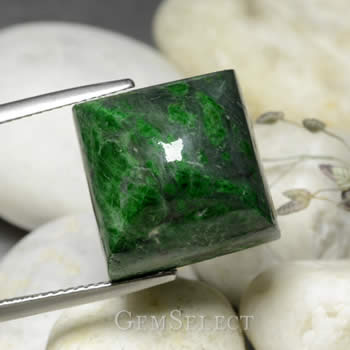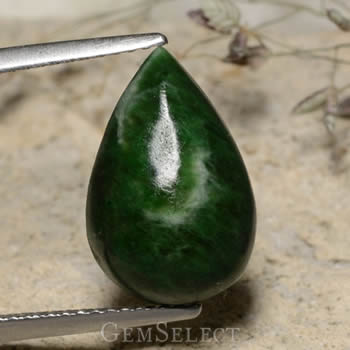Maw-Sit-Sit from Burma
Maw-sit-sit is quite an unusual gemstone due to its curious name and variable chemical composition. It is a recent find, first identified in 1963 by the late Swiss gemologist Dr. Edward Gubelin. It was named after the village in Northwestern Burma (Myanmar) that is close to the site where it was first found. Typically maw-sit-sit is green with distinctive dark-green to black veining.

Maw-Sit-Sit Gemstone from Burma
Maw-sit-sit is considered to be a rock rather than a mineral, since it is composed of a number of different minerals, including kosmochlor (a mineral related to jadeite) and varying amounts of jadeite and albite feldspar. It is often classified as a member of the jade family but it is not really a variety of jadeite. Sometimes maw-sit-sit is called a "cousin" of jade, which seems appropriate.
The source location for maw-sit-sit lies in the foothills of the Himalayas, near the historic imperial jadeite mines of Northern Burma (Myanmar). To date, maw-sit-sit has only been found in this single location, making it a rare material indeed.

Pear-Shaped Maw-Sit-Sit Cabochon
The primary mineral found in maw-sit-sit is kosmochlor, a sodium chromium pyroxene. Kosmochlor makes up approximately 60% of maw-sit-sit and is responsible for both the vibrant emerald green and dark green-black patches. Another significant component is chromium-enriched jadeite, accounting for around 15% of the material. Originally known as ureyite, kosmochlor has an interesting name meaning "green from outer space" due to its discovery in meteorites.
Maw-sit-sit has a refractive index ranging from 1.52 to 1.74, depending on its exact chemical composition. The lower end of the range is most common. It has a hardness rating of 6 to 7 on the Mohs scale and a density or specific gravity ranging from 2.5 to 3.5. Maw-sit-sit is translucent to opaque and is almost always cut as cabochons or carved.
|
